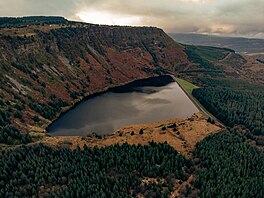| Llyn Fawr | |
|---|---|
 | |
| Location | Rhigos, South Wales Valleys, Wales |
| Coordinates | 51°43′11″N3°34′6″W / 51.71972°N 3.56833°W |
| Lake type | natural lake, reservoir |
| Basin countries | United Kingdom |
| Surface area | 9.8 ha (24 acres) |
| Surface elevation | 368 m (1,207 ft) |
Llyn Fawr ('large lake' in Welsh) is a reservoir that occupies one of a series glacial cirques that form the northern escarpment of the South Wales Coalfield uplands, overlooking the heads of the Vale of Neath and the Cynon Valley, South Wales. It is known as the site of an important hoard of weapons and tools from the late Bronze Age and early Iron Age.
Contents
It lies on the northern flanks of Craig-y-Llyn, a mountain that is designated as a Site of Special Scientific Interest. [1] The western cirque contains Llyn Fach ('small lake'). While in government terms, it falls in the unitary authority of Rhondda Cynon Taf, in geographic terms it is actually in the Vale of Neath and its excess waters (all its water before conversion) flow into Nant Gwrelych, which flows into the River Neath at Pont Walby near Glynneath. Less than 1 km to the southeast and south lie the headwaters of the Rhondda Fawr and Rhondda Fach rivers, while 1.5 km to the southwest lie the headwaters of River Corrwg.
